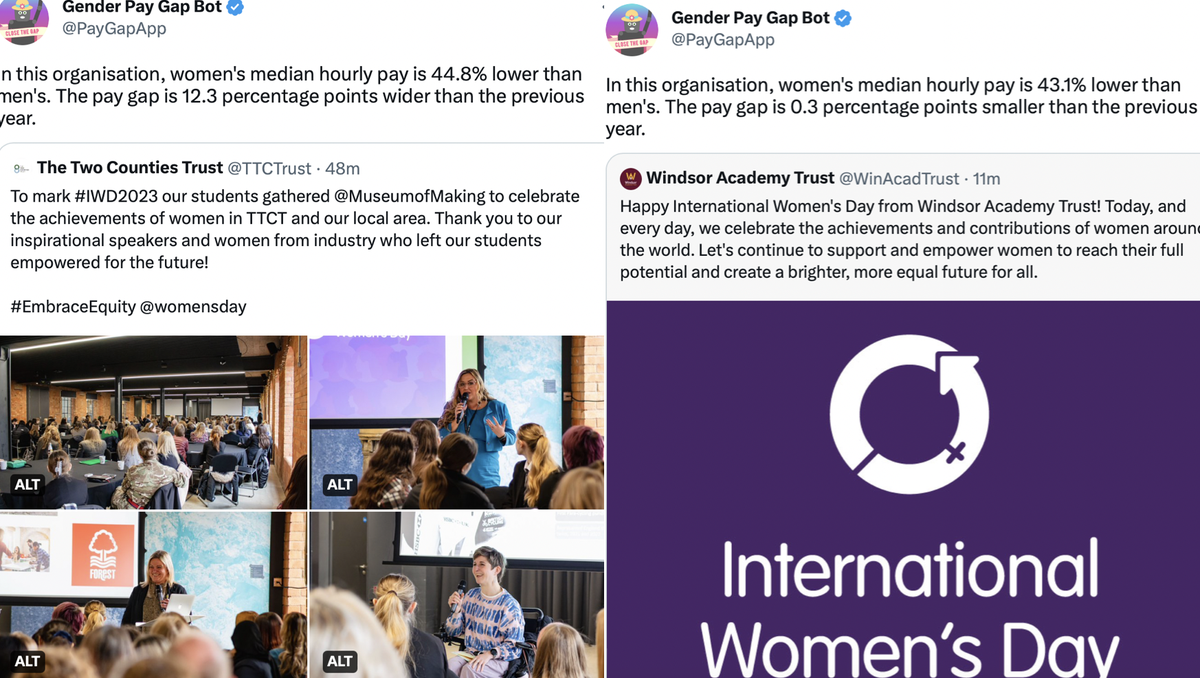Twitter bot savagely calls out companies’ gender pay gaps in response to International Women’s Day tweets

A Twitter bot is calling out various companies for their respective gender pay gaps in response to their tweets about International Women’s Day (IWD).
The automated Twitter account, Gender Pay Gap App, looks at the IWD tweets shared by companies in the UK who are listed on the government’s gender pay gap service website.
The bot searches through “Twitter to match the company names from the government data to their Twitter accounts,” according to the app’s official website. From there, it looks at the account’s recent post and any relevant keywords in it that are tied to IWD. Once a post from the company on the government’s data is found, the Twitter bot will reply to the tweet with the business’ gender pay gap information.
In its automatic responses to the companies’ IWD post, The Gender Pay Gap App brings in the specifics. One example, which is a response Sherborne Girls Day School’s post, reads: “In this organisation, women’s median hourly pay is 38.7% lower than men’s. The pay gap is 37.3 percentage points wider than the previous year.”
The app’s creator, freelance writer Francessca Lawson, first launched the Twitter bot on IWD in 2021 alongside her business partner, software consultant Ali Fensome.
Speaking to The Independent, Lawson shared why she started the app and why gender pay gaps in the UK need to be addressed. She explained that while many companies post about female empowerment on IWD, it’s unclear what other action they’re taking to support women.
“It tapped into a lot of people’s sense of frustrations about how the day is often treated as a marketing opportunity, yet there’s seemingly no accountability for any of the bad stuff,” she explained. “Everyone wants to declare how much they support women and they want to prove themselves to be inclusive and welcoming. But the reality doesn’t often tally with that.”
She added: “Reading something that tells me me how inspirational I am doesn’t make me feel more confident about working my job at night. It’s the classic sort of thing being nice ideas, but actually don’t translate into any real world impact.”
On the UK’s gender pay gap service website, all the employers listed have 250 or more workers. The site examines the pay gap of the organisation by comparing men and women’s average salaries. There are a range of employers on the service, including universities, hospitals, and recruiting companies based in the UK.
In this organisation, women's median hourly pay is 38.7% lower than men's. The pay gap is 37.3 percentage points wider than the previous year. https://t.co/TTn1ab3P9F
— Gender Pay Gap Bot (@PayGapApp) March 8, 2023
Data has also shown the reality of gender inequality both inside and outside of the workplace. Last year, a UK organisation, The Vision for Women’s Health looked at women’s experiences in health and care facilities and found that eight in 10 women felt like their health care professionals weren’t listening to them.
The UK’s UN Women also found in 2021 that 71 per cent of women have experienced a form of sexual harassment in the workplace. Additionally, the UN notes the “women earn 77 cents for every dollar men earn for work of equal value”. The organisation predicts that at this rate, it will take close to 257 years to close the gender pay gap across the world.
Speaking to The Independent, Lawson emphasised how important it is for people to look at the data about the gender pay gap.
“I think it’s important that the public knows that there is data that will challenge or confirm what companies say on social media about gender equality,” she added. “So that’s the important thing to take note of. Look at the facts rather than the vague, corporate words about inclusion.”
Lawson’s message about gender equality also coincides with the UN’s theme of IWD: “DigitALL: Innovation and technology for gender equality”. The theme is focused on the “untold contributions to the digital world” that women have made and continue to make. The organisation also pointed out that “women make up only 22 per cent of artificial intelligence workers globally”.


